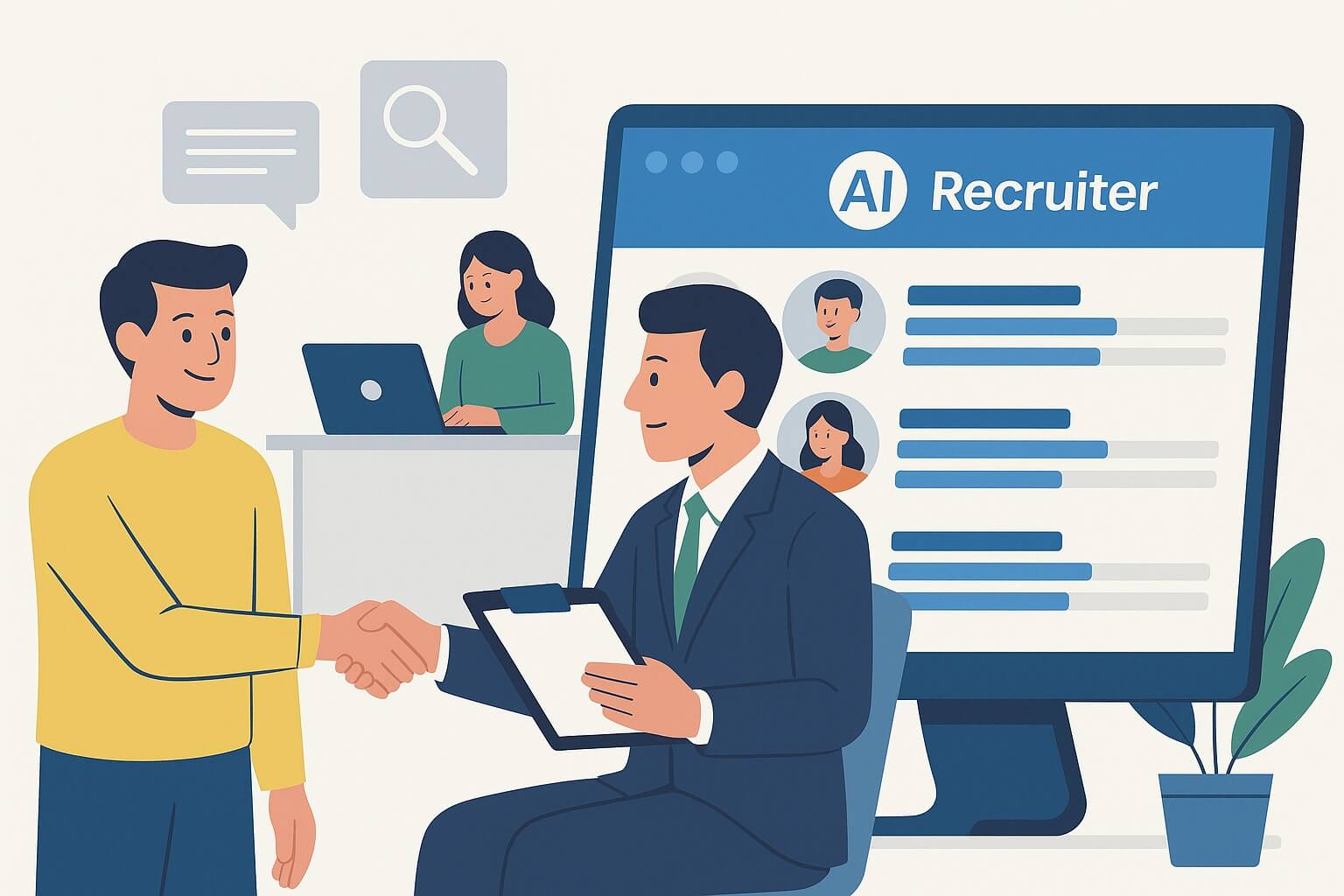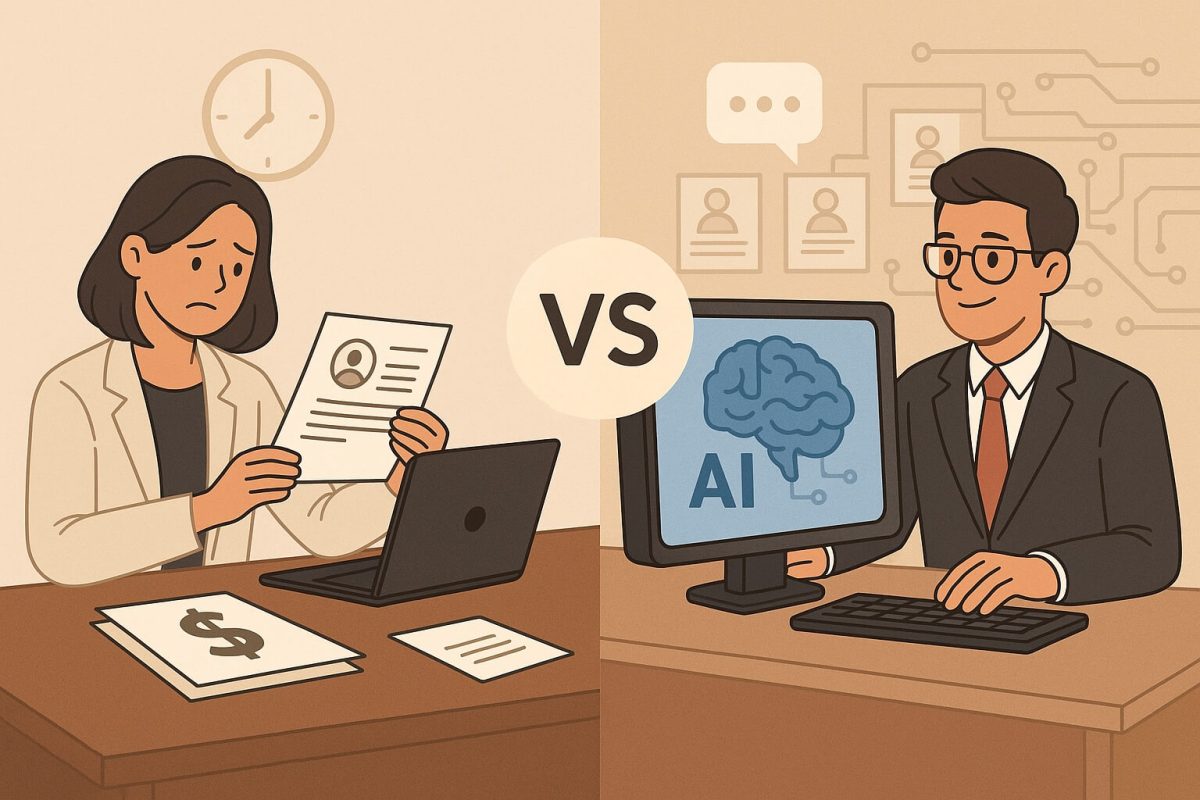Traditional recruitment costs $9,000-17,000 per hire and takes 44+ days. AI recruitment dramatically reduces both—screening 500 resumes in 20 minutes, engaging candidates instantly via chatbot, and automating scheduling. Organizations report 50% cost savings and 75% faster hiring. CloudApper AI Recruiter integrates with your existing ATS/HRIS, enhancing rather than replacing current systems.
Table of Contents
TL;DR:
Traditional recruitment costs 3x more than AI-assisted hiring and takes significantly longer. AI recruitment automates resume screening, candidate engagement, and interview scheduling while integrating with existing ATS/HRIS systems. Organizations see 30-50% cost savings, 40-50% faster hiring, and improved candidate quality. AI handles repetitive tasks while humans focus on relationships and final decisions—delivering better results at lower cost.

For more information on CloudApper AI Recruiter visit our page here.
If you’re still manually reviewing hundreds of resumes, playing phone tag to schedule interviews, and wondering why hiring takes so long, you’re not alone. Traditional recruitment has been the standard for decades, but it’s showing its age. The numbers tell a sobering story: the average time to fill a position is 44 days, and the average cost-per-hire is $4,700 or more.
Meanwhile, organizations using AI-powered recruitment are experiencing something dramatically different. They’re seeing savings of up to 50% on hiring costs, and in some cases, using conversational AI in hiring led to an 87.64% reduction in financial costs compared to traditional methods.
The question isn’t whether AI will transform recruitment—it already has. The question is: what’s actually different between AI and traditional recruitment, and which approach makes sense for your organization?
Let’s break down the real costs, efficiency gains, and practical differences between these two approaches.
What Is Traditional Recruitment?
Traditional recruitment is the manual, human-driven process that most organizations still use today. Here’s what it typically looks like:
The Traditional Hiring Process:
- Post job listings on job boards and your company website
- Collect resumes and cover letters (often hundreds for a single position)
- Manually screen each resume, looking for keywords and relevant experience
- Create a shortlist of candidates
- Play phone tag to schedule initial screening calls
- Conduct multiple rounds of interviews
- Check references manually
- Negotiate offers back and forth via email or phone
- Send offer letters and wait for signatures
This system has its merits, as human insight allows recruiters to pick up subtle cues during conversations that AI might miss. Experienced recruiters can read between the lines on resumes, assess soft skills during phone screens, and make judgment calls based on years of hiring experience.
But here’s the problem: this approach doesn’t scale. When you have 300 applications for one position, or you’re trying to fill 50 positions simultaneously, the traditional method breaks down.
The Hidden Costs of Traditional Recruitment
Most organizations drastically underestimate how much traditional recruitment actually costs. Let’s look at the real numbers:
Direct Costs:
- Traditional recruitment agencies typically charge between 15% and 25% of the candidate’s first-year compensation. For a $75,000 position, that’s $11,250 to $18,750 per hire.
- Employing two in-house recruiters may cost a company more than $260,000 annually
- Job board postings typically cost $300-$500 per listing
- Background checks, assessments, and other screening tools add up quickly
Hidden Costs:
- Time invested: Your hiring managers and HR team spend countless hours screening resumes, conducting interviews, and coordinating schedules
- Lost productivity: Every day a position remains unfilled, you’re losing the productivity that person would bring
- Opportunity cost: While your team manually screens applications, competitors with faster processes are hiring your best candidates
- Bad hires: Manual screening increases the risk of overlooking red flags or hiring based on gut feeling rather than objective criteria
When you add everything up, the real cost often climbs to three or four times the position’s salary.
Problems with Traditional Recruitment
Beyond cost, traditional recruitment faces serious efficiency challenges:
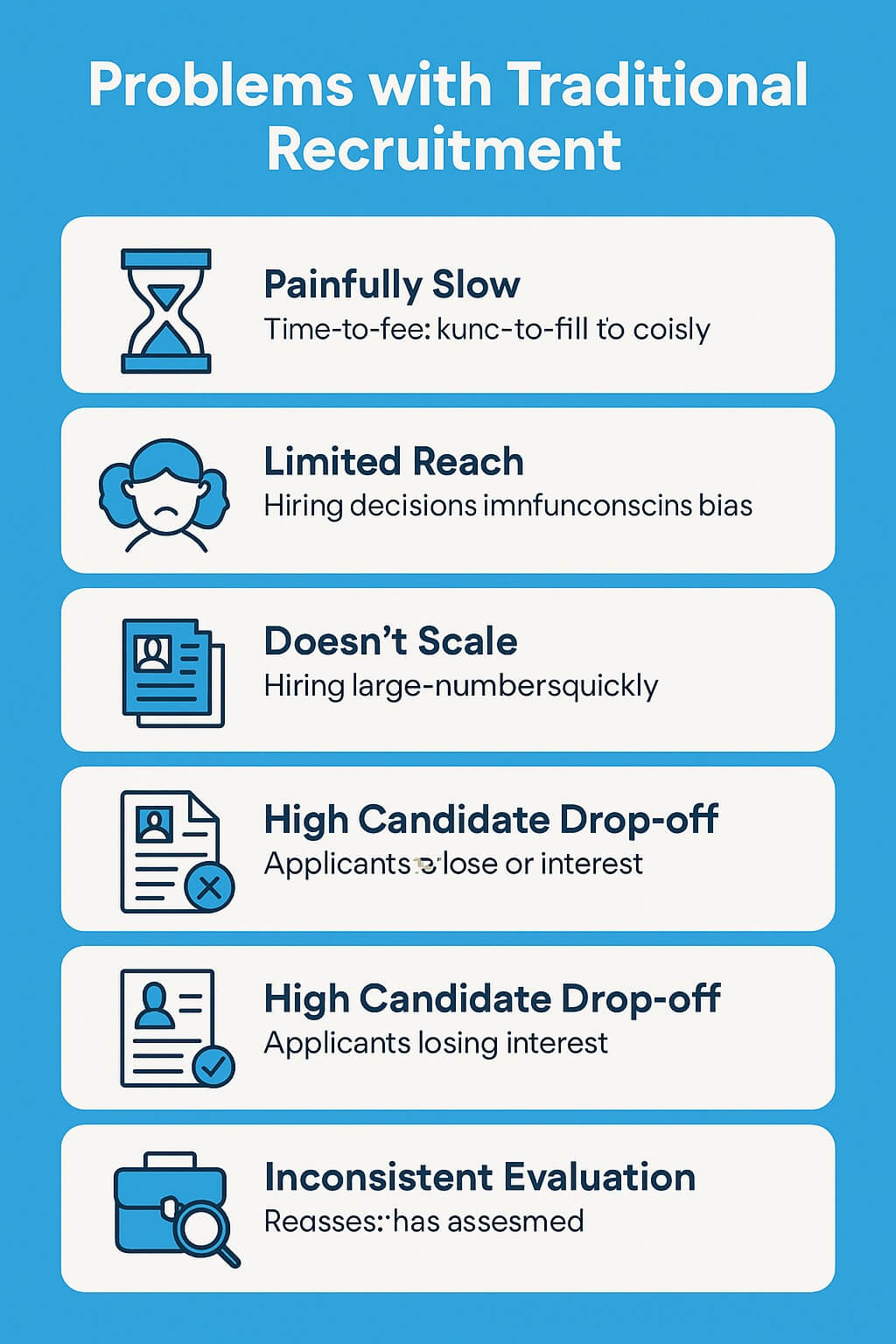
Painfully Slow: The average time-to-fill is too long and costly. In competitive job markets, your best candidates accept other offers while you’re still scheduling first-round interviews.
Limited Reach: Traditional methods struggle to access diverse talent pools. You’re often limited to people who happen to see your job posting on specific boards or who are already in your network.
Unconscious Bias: Research confirms hiring decisions are often swayed by names, schools, or backgrounds. Even well-intentioned recruiters make decisions influenced by unconscious preferences.
Doesn’t Scale: When you need to hire 10, 50, or 100 people quickly, traditional methods simply can’t keep up. You’d need to dramatically expand your recruiting team, which isn’t feasible or cost-effective.
High Candidate Drop-off: More than 9 in 10 job seekers (92%) never complete their applications. Long, cumbersome application processes and lack of communication cause candidates to abandon the process.
Inconsistent Evaluation: Different recruiters apply different criteria. The candidate you interview on Monday might be evaluated differently than an identical candidate you meet on Friday, simply because you’re tired or had a bad morning.
What Is AI Recruitment?
AI recruitment uses artificial intelligence, machine learning, and automation to handle repetitive recruiting tasks while supporting smarter, data-driven hiring decisions. Rather than replacing human recruiters, AI handles the heavy lifting so your team can focus on what humans do best: building relationships, assessing cultural fit, and making final hiring decisions.
How AI Recruitment Works
Modern AI recruiting tools integrate directly with your existing HR systems—your ATS, HRIS, or HCM platform. They don’t replace these systems; they enhance them by adding intelligent capabilities at the front end of your recruiting pipeline.
Here’s what a typical AI-powered recruiting process looks like:
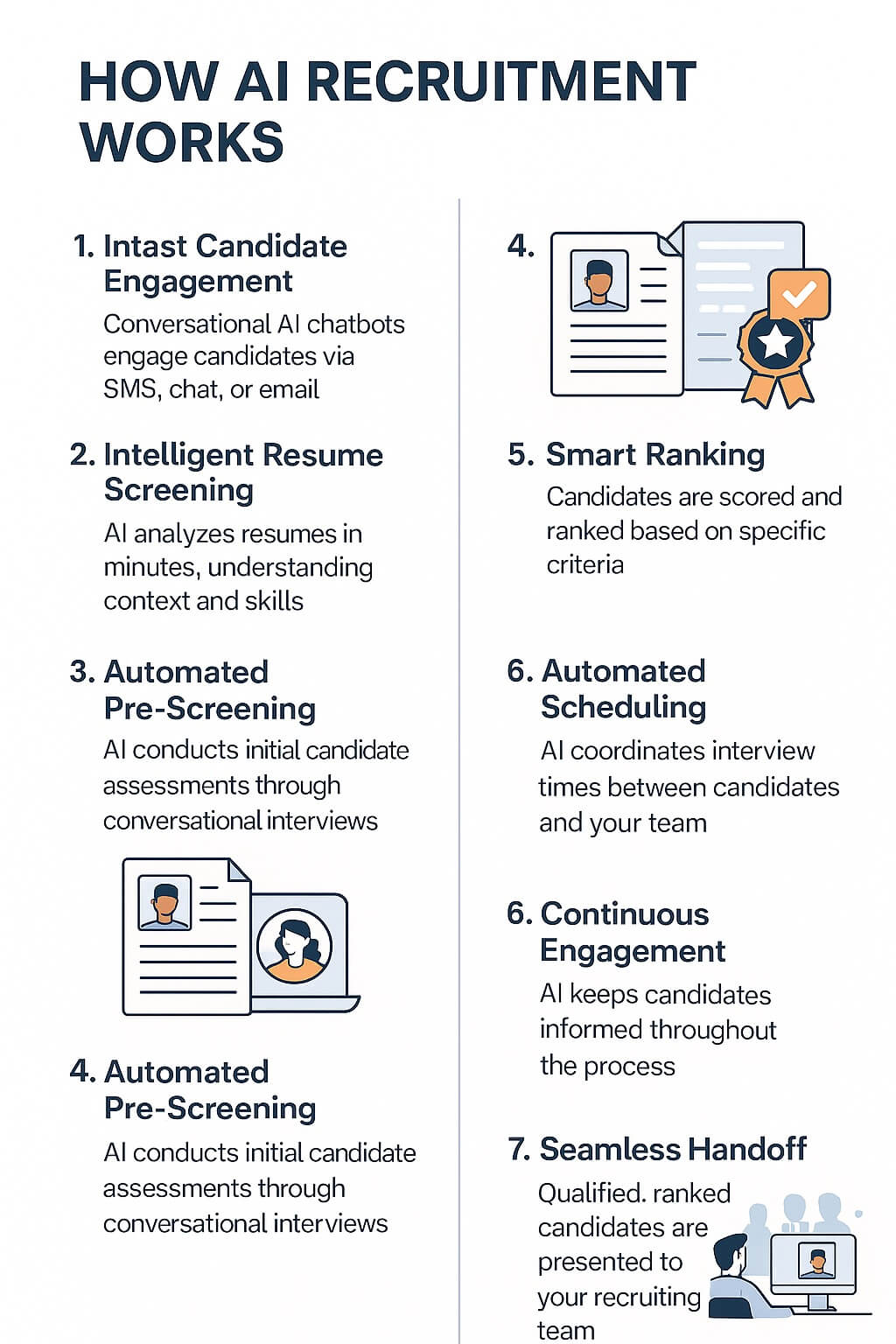
- Instant candidate engagement: Conversational AI chatbots engage candidates immediately via SMS, chat, or email—24/7, in multiple languages
- Intelligent resume screening: AI analyzes hundreds or thousands of resumes in minutes, understanding context and skills beyond simple keyword matching
- Automated pre-screening: AI conducts initial candidate assessments through conversational interviews, asking role-specific questions and verifying qualifications
- Smart ranking: Candidates are scored and ranked based on your specific criteria—skills, experience, certifications, availability
- Automated scheduling: AI coordinates interview times between candidates and your team without any back-and-forth
- Continuous engagement: AI keeps candidates informed throughout the process with automated updates and responses to questions
- Seamless handoff: Qualified, ranked candidates are presented to your recruiting team for final interviews and decisions
How CloudApper AI Recruiter Enhances Your Existing Systems
CloudApper AI Recruiter is designed specifically to integrate with your current HR technology stack. Whether you’re using UKG, Workday, SAP SuccessFactors, Oracle, Dayforce, or another major platform, CloudApper connects seamlessly to add powerful AI capabilities without replacing your existing investment.
What makes it different:
Integration-first approach: CloudApper pulls resumes directly from your ATS, analyzes them using advanced AI, and pushes ranked candidates back into your system. Everything stays synchronized in one place.
Conversational AI engagement: The system engages candidates through natural, human-like conversations via SMS, WhatsApp, web chat, or email. Candidates can even apply by texting a number or scanning a QR code—no long forms required.
Contextual resume analysis: Unlike simple keyword matchers, CloudApper uses natural language processing to understand the full context of a candidate’s background, skills, and experience. It recognizes that “led cross-functional projects” demonstrates project management skills even without using those exact words.
Dynamic pre-screening: The AI conducts personalized scenario-based assessments, asking candidates role-specific questions to verify their actual capabilities—not just what they claim on a resume.
Smart candidate ranking: Every candidate receives a score based on your customizable criteria—skills, certifications, experience level, availability, salary expectations, or any other factors that matter to your organization.
Automated coordination: From interview scheduling to reminder notifications, the system handles all the coordination tasks that normally consume hours of recruiter time.
Mobile-friendly experience: Candidates can complete the entire process from their phones, dramatically reducing drop-off rates.
Cost Comparison: AI vs Traditional Recruitment
Let’s compare the real costs of these two approaches with concrete numbers.
Traditional Recruitment Costs
For a $75,000 position using an agency:
- Agency fee (20%): $15,000
- Job board postings: $500
- Background checks: $100
- Time spent by internal team (40 hours at $50/hour): $2,000
- Total: $17,600 per hire
For internal recruitment team:
- Two recruiters’ annual salaries: $260,000
- Job board subscriptions: $12,000/year
- Assessment tools: $5,000/year
- If filling 30 positions per year: $9,233 cost per hire
AI Recruitment Costs
AI-powered recruitment platforms typically use subscription-based pricing models, offering a simpler and more predictable cost structure compared to traditional agency fees or unpredictable hiring expenses. The exact investment varies based on your organization’s size, hiring volume, and the specific features you need.
What makes AI recruitment cost-effective
Unlike traditional methods where costs multiply with each hire (agency fees of 15-25% per position, constant job board renewals, per-assessment charges), AI platforms typically charge a flat subscription rate. This means your per-hire cost decreases dramatically as your hiring volume increases.
The cost advantage: Organizations consistently report that AI-assisted recruitment costs significantly less than traditional methods—with many seeing their cost-per-hire drop by half or more. The more you hire, the better your ROI becomes.
Return on Investment
Most organizations see positive ROI within 3-6 months of implementing AI recruiting tools. Here’s why:
Direct savings:
- Dramatically lower cost per hire compared to agency fees
- Reduced reliance on expensive external recruiters
- Fewer internal resources needed for time-consuming screening tasks
- Lower job board spending due to higher-quality applications
Efficiency gains:
- AI tools significantly shorten the hiring process through automation
- Positions get filled faster, reducing lost productivity from vacant roles
- Your team can handle more requisitions with the same headcount
- Less time wasted on unqualified candidates
Quality improvements:
- Better candidate matching reduces bad-hire costs (which typically equal 30% of first-year salary)
- Using AI recruitment can increase revenue per employee by an average of 4%
- Improved diversity leads to better team performance and innovation
- Higher offer acceptance rates due to better candidate experience
Real-world impact: A mid-sized company filling 50 positions annually could save hundreds of thousands of dollars per year while simultaneously improving hiring speed and candidate quality. The larger your hiring volume, the more dramatic your savings become.
The key insight: AI recruitment isn’t an expense—it’s an investment that pays for itself many times over through reduced costs, faster hiring, and better quality candidates.
Efficiency Comparison: Speed and Scale
Cost savings are just part of the story. The efficiency differences between AI and traditional recruitment are even more dramatic.

Time-to-Hire
Traditional recruitment:
- Resume screening: 2-5 days for 100+ applications
- Initial outreach and scheduling: 3-7 days of back-and-forth
- First-round interviews: 1-2 weeks to coordinate
- Second-round interviews: Another 1-2 weeks
- Reference checks and decision: 3-5 days
- Total: 4-6 weeks minimum, often 44+ days
AI recruitment:
- Resume screening: Minutes for thousands of applications
- Automated engagement: Instant, 24/7
- Pre-screening assessments: Completed within hours
- Interview scheduling: Automated coordination in minutes
- Ranked shortlist ready: Same day or next day
- Total: 1-2 weeks for complete hiring cycle
Organizations using CloudApper AI Recruiter report reducing time-to-hire by as much as 97%. What used to take weeks now happens in days or even hours.
Scale and Volume
This is where AI recruitment truly shines.
Traditional recruitment with high volume:
- One recruiter can thoroughly screen about 50-100 resumes per day
- For 500 applications, that’s 5-10 full days of work
- Coordination becomes increasingly chaotic
- Quality suffers as recruiters rush through applications
AI recruitment with high volume:
- AI tools can process 500 resumes in under 20 minutes
- AI handles large-scale recruitment effortlessly, operating around the clock and supporting multilingual candidates
- No decrease in quality regardless of volume
- Every candidate evaluated consistently
CloudApper AI Recruiter is designed specifically for high-volume hiring scenarios like retail, healthcare, logistics, hospitality, and call centers. Whether you have 50 or 5,000 applications, the system processes them with the same speed and accuracy.
Candidate Experience
Speed matters to candidates too. 49% of job applicants believe they didn’t get the job if they haven’t heard back within two weeks of applying, and 62% of job seekers lose interest if they don’t hear back within two weeks.
Traditional recruitment candidate experience:
- Submit application → silence for days or weeks
- Wonder if application was received
- No transparency about where you stand
- Eventually give up and accept another offer
AI recruitment candidate experience:
- Submit application → instant acknowledgment
- Immediate conversation with AI chatbot
- Complete pre-screening within minutes
- Receive interview invitation same day or next day
- Stay informed throughout process
CloudApper AI Recruiter keeps candidates engaged through SMS, chat, and email, answering questions instantly and providing updates automatically. This transparency and speed dramatically improve candidate satisfaction and reduce drop-off rates.
Quality of Hire: Which Approach Finds Better Candidates?
Here’s a question that matters more than cost or speed: which method actually finds better candidates?
Traditional Recruitment Quality Issues
Traditional screening has significant limitations:
Resume-dependent: Recruiters rely heavily on what candidates write about themselves, which may not reflect actual capabilities
Inconsistent: Different recruiters evaluate the same resume differently depending on time of day, workload, mood, or personal preferences
Keyword-focused: Manual screening often looks for specific words rather than understanding context and transferable skills
Unconscious bias: Even the most well-meaning recruiters can unintentionally let unconscious bias affect their decisions
Volume limitations: When faced with hundreds of applications, even dedicated recruiters must rush, potentially overlooking strong candidates
AI Recruitment Quality Advantages
AI recruitment addresses these limitations:
Skills verification: Rather than trusting resumes, AI can conduct scenario-based assessments that test actual capabilities
Consistency: Candidates who underwent AI-led interviews succeeded in subsequent human interviews at a significantly higher rate (53.12%) compared to candidates from the traditional resume screening group (28.57%)
Context understanding: Advanced AI understands skills and experience beyond simple keyword matching, recognizing transferable abilities and relevant background
Bias reduction: CloudApper AI Recruiter reduces both conscious and unconscious bias by analyzing candidates strictly on skills, experience, and job criteria. It can anonymize resumes by removing names, gender indicators, and other identifiers.
No quality degradation with volume: Whether evaluating 10 or 10,000 candidates, AI applies the same rigorous criteria to each one
Data-driven insights: AI provides real-time analytics for ongoing improvements, helping you refine your hiring criteria based on what actually predicts success
14% more AI-picked candidates are more likely to pass the interview, demonstrating that AI screening effectively identifies candidates who will succeed in the hiring process.
Integration: How AI Works With Your Existing Systems
One of the biggest concerns organizations have about AI recruitment is: “Will this require us to replace our current systems?”
The answer is no—at least not with modern, integration-focused solutions like CloudApper AI Recruiter.
Why Integration Matters
HR teams are using 21 different modules, on average, to complete their work, which has doubled since 2019. The last thing you need is another disconnected system creating more complexity.
The right AI recruiting solution integrates seamlessly with your existing HR technology stack:
ATS integration: CloudApper connects with all major applicant tracking systems, pulling candidate data in and pushing ranked results back out
HRIS integration: Integrating an ATS and the company’s HRIS can save employees time by automatically transferring new hire information
Calendar integration: Automated scheduling works with Google Calendar, Outlook, and other platforms your team already uses
Communication integration: Engage candidates through the channels they prefer—SMS, email, Slack, Teams, WhatsApp
Background check integration: Connect screening vendors directly to streamline the verification process
Benefits of Integrated AI Recruitment
When applicant tracking system integrations replace copy-paste work, recruiters save hours each week. Here’s what good integration delivers:

Single source of truth: All candidate information lives in your existing HR system, with AI adding intelligence to the screening and engagement process
No duplicate data entry: Information flows automatically between systems, eliminating manual copying and the errors that come with it
Unified workflows: Your team doesn’t need to learn entirely new processes—AI enhances the workflows you already have
Complete visibility: Everyone involved in hiring sees the same, current information regardless of which system they’re accessing
Preserved investments: You keep the HR technology you’ve already invested in and trained your team on
CloudApper AI Recruiter is built specifically to integrate with platforms like UKG, Workday, Oracle, SAP SuccessFactors, and Dayforce. The system enhances your existing investment rather than requiring you to start over.
What AI Can and Cannot Do
To make an informed decision about AI recruitment, you need to understand both its capabilities and limitations.
What AI Does Exceptionally Well
Automating repetitive tasks: Sorting resumes, sending follow-up emails, scheduling interviews, answering common candidate questions—AI handles these perfectly
Processing large volumes: AI can screen thousands of applications with consistent quality, something no human team can match
Eliminating unconscious bias: When configured properly, AI evaluates candidates based solely on job-relevant criteria
Maintaining consistency: AI applies the exact same standards to every candidate, every time
Engaging instantly: 24/7 availability means candidates always get immediate responses
Extracting insights: AI identifies patterns in successful hires that humans might miss
What AI Cannot Replace
Human judgment on cultural fit: While AI can assess skills and experience, humans are still better at evaluating whether someone will thrive in your specific work environment
Complex negotiations: Offer discussions, especially for senior roles, require human nuance and flexibility
Building relationships: Top candidates want to feel valued and understood—something humans do better than AI
Handling unique situations: When a candidate has an unusual background or special circumstances, human judgment is essential
Making final hiring decisions: AI enhances recruiters, it does not replace them. Humans should always make final hiring decisions.
The ideal approach combines AI’s efficiency and consistency with human judgment and relationship-building. CloudApper AI Recruiter handles the screening, assessment, coordination, and engagement, delivering qualified, ranked candidates to your team for final interviews and decisions.
Real-World Impact: What Organizations Are Experiencing
Let’s look at concrete examples of how AI recruitment transforms results:
Cost Savings
Organizations report dramatic cost reductions:
- Unilever’s AI-driven system cut hiring costs by 50%
- Early adopter companies implementing AI sourcing tools are seeing a 75% reduction in cost per screen
- Reduced reliance on expensive recruitment agencies
- Lower internal resource requirements
Time Savings
The efficiency gains are even more impressive:
- AI tools can process 500 resumes in under 20 minutes—about 2.5 seconds per resume compared to 180 seconds manually—cutting initial screening time by approximately 75%
- An effective ATS can decrease the average hiring cycle by as much as 60%
- What used to take weeks now happens in days
Quality Improvements
AI doesn’t just save money and time—it improves outcomes:
- Unilever improved both candidate quality and diversity while cutting costs
- Better candidate matching reduces turnover
- More consistent evaluation creates fairer hiring
Adoption Trends
The momentum behind AI recruitment is undeniable:
- 87% of companies now use AI-driven tools, with 65% of recruiters already implementing AI
- Primary motivations include saving time (44%), improving candidate sourcing (58%), and reducing hiring costs
- 79% of organizations have integrated AI or automation directly into their ATS
Common Concerns About AI Recruitment
Despite clear benefits, some organizations hesitate to adopt AI recruitment. Let’s address common concerns:
“Will AI miss great candidates?”
Actually, the opposite is often true. 88% of employers believe they are losing out on highly qualified candidates who are screened out of hiring processes by ATSs because they aren’t submitting ‘ATS-friendly’ resumes—but that’s a problem with old keyword-matching systems, not modern AI.
CloudApper AI Recruiter uses contextual analysis to understand skills and experience beyond keywords. It recognizes that someone who “coordinated cross-functional initiatives” has project management experience even without using those exact words. This actually helps you find great candidates who might be overlooked in manual screening.
“What about candidate privacy?”
CloudApper AI Recruiter protects candidate data through encryption, secure storage, controlled access, and compliance with regulations such as GDPR. Candidate consent is recorded, data is stored safely, and access to sensitive information is restricted.
Responsible AI recruitment tools are actually more secure than traditional methods, which often involve emailing resumes and candidate information without encryption.
“What if candidates don’t like talking to AI?”
Modern conversational AI has evolved significantly. Conversational AI uses natural language processing and machine learning to understand nuances of syntax and semantics, responding to candidates in human-like ways.
Most candidates actually prefer instant AI responses over waiting days or weeks for human responses. They appreciate the speed, transparency, and convenience—especially being able to complete everything from their phones.
“Is this only for large enterprises?”
AI recruitment tools are not only for large enterprises. Small HR teams often benefit most because AI eliminates the bottlenecks that occur when a few people try to manage high application volumes.
CloudApper AI Recruiter is cost-effective and scalable, making it accessible for organizations of all sizes.
“How long does implementation take?”
CloudApper teams help configure workflows, import job data, connect your ATS, and launch your recruitment automation in just a few days. You can begin seeing results immediately.
Implementation doesn’t require months of work or massive disruption to your existing processes.
Making the Decision: When Does AI Recruitment Make Sense?
AI recruitment isn’t necessarily right for every organization in every situation, but it makes tremendous sense in these scenarios:
High application volume: If you regularly receive 100+ applications per position, manual screening becomes unsustainable
Multiple open positions: When you’re trying to fill several roles simultaneously, AI dramatically increases your capacity
Speed-sensitive hiring: In competitive markets where top candidates accept offers quickly, AI’s speed advantage is crucial
High-volume seasonal hiring: Retail, hospitality, and other industries with seasonal surges benefit enormously from AI’s scalability
Limited recruiting resources: Small HR teams can handle much larger workloads with AI assistance
Diversity and inclusion goals: AI helps eliminate unconscious bias and create more consistent, fair evaluations
Cost reduction pressure: When you need to lower cost-per-hire without sacrificing quality
Candidate experience focus: When improving applicant experience and reducing drop-off is a priority
Getting Started with AI Recruitment
If you’re ready to explore AI recruitment, here’s how to begin:
1. Assess your current process: Identify where you’re spending the most time and where bottlenecks occur
2. Define your goals: Are you primarily focused on reducing costs, improving speed, handling more volume, or improving quality?
3. Evaluate integration needs: Make sure any AI solution integrates seamlessly with your existing ATS, HRIS, or HCM platform
4. Start with a pilot: Test AI recruitment on a specific department or job type before rolling out organization-wide
5. Measure results: Track metrics like time-to-hire, cost-per-hire, candidate quality, and offer acceptance rates
6. Iterate and improve: Use data from your AI system to continuously refine your hiring criteria and processes
CloudApper AI Recruiter makes getting started simple. The team helps you configure everything based on your specific needs, integrates with your existing systems, and provides support throughout implementation.
The Bottom Line: AI vs Traditional Recruitment
The data is clear: traditional recruitment methods cost 3x more than AI-assisted hiring. Organizations using AI recruitment are saving 30-50% on hiring costs while simultaneously filling positions 40-50% faster and improving candidate quality.
But this isn’t about AI replacing recruiters or eliminating the human element from hiring. It’s about intelligent automation handling the repetitive, time-consuming tasks so your team can focus on what humans do best: building relationships, assessing cultural fit, and making thoughtful hiring decisions.
Traditional recruitment works when:
- You’re filling one or two specialized positions per year
- You have abundant recruiting resources relative to hiring volume
- Speed isn’t a competitive factor in your market
- You’re comfortable with the current costs and timelines
AI recruitment makes sense when:
- You need to process high application volumes
- Speed and efficiency directly impact your ability to hire top talent
- You’re looking to reduce costs without sacrificing quality
- You want to eliminate unconscious bias and improve diversity
- Your team is overwhelmed with administrative recruiting tasks
- You need consistent evaluation across all candidates
The future of recruitment isn’t human OR AI—it’s human AND AI working together. AI handles the heavy lifting of screening, assessment, coordination, and engagement, while humans bring judgment, empathy, and relationship-building to the final stages of hiring.
With CloudApper AI Recruiter, you get the best of both worlds: powerful AI capabilities that integrate seamlessly with your existing HR systems, delivering qualified candidates faster and more cost-effectively than traditional methods ever could.
Ready to transform your recruiting process? See how CloudApper AI Recruiter can integrate with your ATS, HRIS, or HCM system to add intelligent automation that saves time, reduces costs, and improves hiring outcomes.
What is CloudApper AI Platform?
CloudApper AI is an advanced platform that enables organizations to integrate AI into their existing enterprise systems effortlessly, without the need for technical expertise, costly development, or upgrading the underlying infrastructure. By transforming legacy systems into AI-capable solutions, CloudApper allows companies to harness the power of Generative AI quickly and efficiently. This approach has been successfully implemented with leading systems like UKG, Workday, Oracle, Paradox, Amazon AWS Bedrock and can be applied across various industries, helping businesses enhance productivity, automate processes, and gain deeper insights without the usual complexities. With CloudApper AI, you can start experiencing the transformative benefits of AI today. Learn More
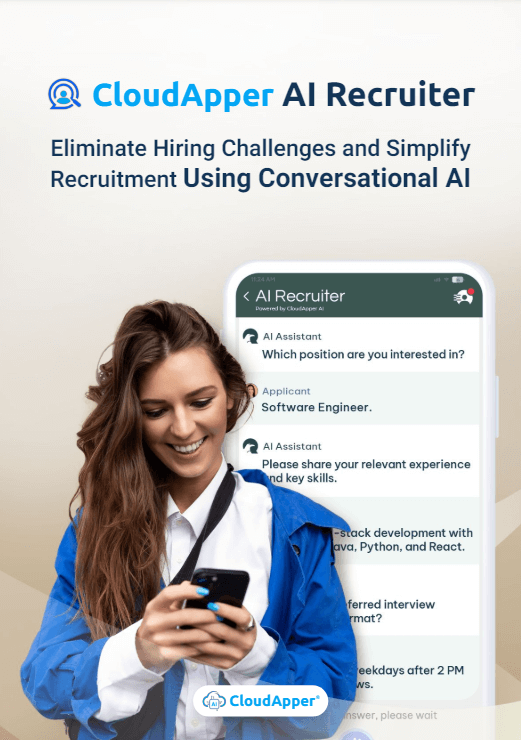
CloudApper AI Solutions for HR



- Works with
- and more.
Similar Posts

How to Use AI in Recruiting: A Complete Guide for…

10 Essential Registered Nurse (RN) Interview Questions to Ask (And…
